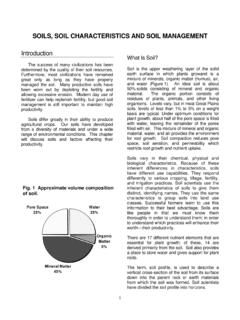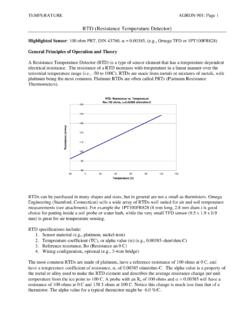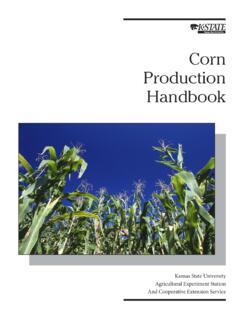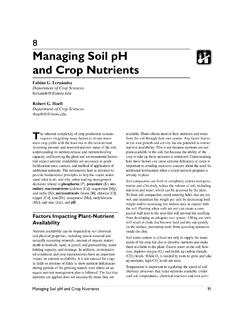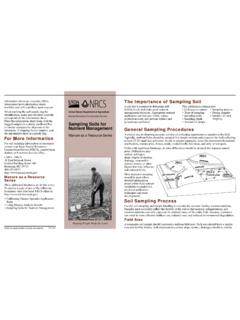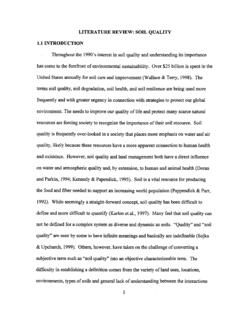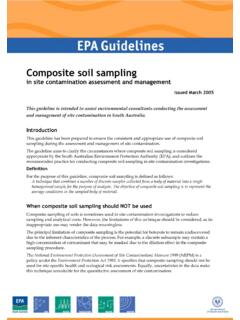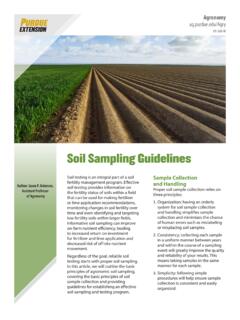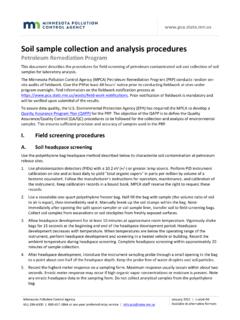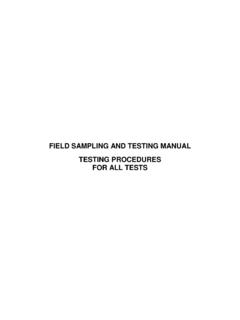Transcription of SOIL SAMPLING AND SOIL TESTING - Agronomy
1 soil SAMPLING AND soil TESTING . soil TESTING has been promoted for many crop growth and development. In general, years as the basis for making sound lime and crops are more dependent on nutrients fertilizer use decisions. However, supplied as fertilizers as low soil test levels misunderstandings still exist on what can and and become less responsive to fertilizer cannot be gained from TESTING . A testament to nutrients as soil test levels increase. these misunderstandings is the number of acres that do not have good historical soil test Typical Yield Response to Fertilizer information. There are several components to High sound soil TESTING programs, namely: 1). proper collection and care of the sample, 2). Yield Response to appropriate test procedures, 3) well Fertilizer researched interpretation guidelines of the test results and 4) development of appropriate nutrient rate recommendations and 5) integration of rate requirements into overall nutrient management programs.
2 Low Very Low Low Medium High Very High soil test information is the cornerstone for developing cost effective, efficient and soil Test Values environmentally sound nutrient management programs. In fact, developing a sound Without knowledge of the soils ability to nutrient management plan is not possible supply required nutrients to the growing without the implementation of a sound soil crop it is impossible to determine which TESTING program. Without good soil test supplemental nutrients must be applied to historical information, it is impossible for provide for efficient and profitable crop farmers and their advisors to intelligently production. decide which nutrients, if any, need to be applied, how much of each nutrient is soil TESTING is also used to aid in developing required and the best method/time of nutrient liming programs, for identifying and correcting application.
3 soil salinity and alkali problems and for arriving at appropriate herbicide rates in Critical to the building of a good historical soil weed management programs. test information data base is the proper collection of soil samples to be submitted to Collection and Care Of soil the laboratory. soil SAMPLING is the foundation upon which the entire soil Samples TESTING /nutrient management planning process rests. If the foundation is bad ( soil A sample is taken from the field for the SAMPLING technique), the integrity of the chemical or physical measurements whole house built upon this foundation is desired, because it is neither practical not questionable (nutrient management possible to test an entire field. The accuracy decisions). As a result, it is very important with which these measurements that the people collecting soil samples be characterize the true field conditions depend properly trained to do the job correctly.
4 On obtaining a representative soil sample. An acre of soil to a 6-inch depth weighs The purpose of soil TESTING is to estimate the about 2,000,000 pounds. This means that ability of the soil to supply required nutrients the sampler is using a sample weighing to growing crops and/or aid in diagnosing roughly a pound to represent several certain soil problems that may hinder efficient million pounds of soil depending on the 101. within a field. Most production fields are sampled by collecting 15-20. individual subsamples from a field, or portion of a field, compositing the individual cores in a pail, thoroughly mixing the collected soil and then submitting a single sample to the laboratory for analysis. The idea is to randomly collect enough individual soil cores to acres represented by the sample.
5 Thus, ensure that the resulting there is plenty of room for error. This sample submitted to the laboratory will be has lead to the statement that That test representative of the field, or portion of the field, in question. is no better than the sample collected in the field. While variability from one end of the field to the next is one reason that 15-20 individual In order to be useful, the soil sample must cores need to be composited into a single be taken so that it is representative of the sample submitted to the laboratory, inch-to- area being sampled. It must accurately inch variability also exists. This inch-to-inch represent the field or area sampled in order variability is part of the natural variation in to obtain soil test results that can be soils, but other factors also contribute.
6 For properly interpreted. example, several fertilizer granules may roll into small depressional areas on the soil soil SAMPLING is the weakest link in the soil surface where an individual core is collected TESTING -nutrient management plan from. Likewise livestock or wildlife activities development process and is the greatest may result in hot spots' in fields from which a source of error. There is tremendous single core is collected from. The way to variability in soil within fields, even in those manage field wide and inch-to-inch variability that appear uniform. soil SAMPLING must is to collect enough subsamples (cores) to account for this variability in order to ensure minimize the effect. sound nutrient management decisions. Research conducted by North Dakota State Collecting composite samples Variability of University illustrates the importance of soils in many fields is fairly obvious since compositing 15 to 20 individual cores into a there may be significant visual differences in single sample.
7 In their work, collecting 15 to topography, soil types, soil color or other 20 cores were needed to obtain results +/- factors. But field variability exists that is not 15% of the true average of the field 80% of evident at first glance even in fields that the time or +/- 20% of the true average appear uniform. Because of the non-uniformity of fields, collecting several soil samples from within a single field and/or compositing many subsamples (individual soil cores) for each sample collected is necessary to accurately define soil characteristics 102. 90% of the time. If only 50 or 6 individual cores were collected, the results would be +/- 25% of the true average only 75% of the time. Collecting an adequate number of cores is required to minimize year to year soil test variability.
8 The size of the area to be represented by a single, composited soil sample has relatively little influence on the number of Collecting individual cores from these areas and including in the overall field composite sample will only create a soil in the pail that doesn't exist in the field. Alternatively, some producers and crop advisors divide whole fields into multiple management zones and collect one composite sample from each soil zone. Examples of subsamples required to ensure a management zones within a field that may representative' sample. In general, the size differ are soil types, topographies (top, of the field to be sampled, about 15-20. bottom, side of hills), soil texture, manure individual cores are needed to minimize the history, cropping systems, and others.
9 The effects of the natural variability found in soils. idea of separating whole fields into smaller For fields larger than 50 to 80 acres it would management zones is that soil test variability be appropriate to include at least one within a management zone will hopefully be additional soil core for each five acres in less than the variability across management excess of 80 acres. Better yet, submit two zones. separate samples consisting of 15. to 20 cores from larger fields. The following presents some examples several possible composite SAMPLING strategies for different fields/situations. For uniform fields with no apparent differences a single composite sample from whole field would be appropriate. soil cores should not be collected from odd places such as headlands, dead furrows, low spots, knolls, etc.
10 If the area covers a large enough portion of a field ( 10- 20%), a separate composite sample should If portions of a field have had different be collected from the area and submitted to manure management programs, previous the laboratory. crop history or other cultural differences, 103. With the advent of precise positioning systems (Differentially corrected Global Positioning System, DGPS) and more powerful and sophisticated computer hardware and software ( Geographical Information Systems, GIS) intensively collecting multiple soil samples from within a field to accurately identify and map field variability is now a cost effective reality. separate composite samples should be collected from each subfield and submitted to Grid cell SAMPLING is most commonly the laboratory.
